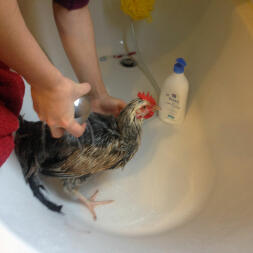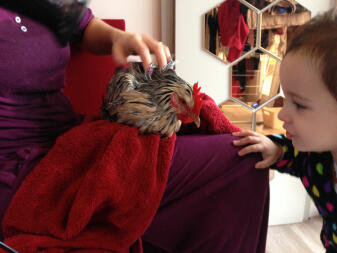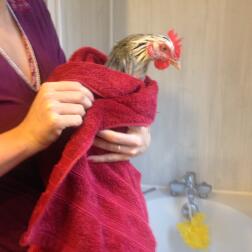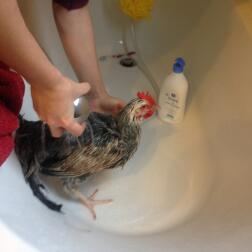Unless you show your chickens, the only circumstance in which you'll need to wash them is if they’re really grubby – for example, if there was a heavy rainfall and now they’re covered in mud. Chickens can find bathing quite a stressful, chilly experience, but if you do it correctly then some might rather enjoy it.
Before you begin, some very important things to remember are to not leave your chickens on their own when in water, and to not leave them to dry in a cold environment.
- Make sure it’s a warm day
Chickens don’t cope well with being wet. They lose all of their insulation, and so they’ll be extremely cold. It’s best to only bathe your chickens on warm days, or to keep them in a warm environment post-wash. - Prepare the washing equipment before you begin
You’ll need a sink or a bucket full of warm water, unless it’s an extremely hot day when lukewarm or cool water may be preferable to stop your chooks overheating. You’ll either need some special poultry shampoo (or baby shampoo), a towel, a cotton wool bud, and a hairdryer that has a cool setting. It’s often useful to have a toothbrush to help clean your chicken’s feet, too. - Wash one chicken at a time
Place your chicken gently in the water, but don’t submerge their head. Make sure that their feathers are all wet, as some may have some waterproofing. Using your fingers, smooth some water onto your chicken’s head. - Lather the soap in
Remove your chicken from the water, and apply the soap. Be as gentle as possible, taking care not to get any soap in your pet's eyes or nostrils. Carefully remove dirt from your chickens legs using the toothbrush, being careful not to scrub too vigorously. - Rinse
Rinse your chicken with warm water. Do so thoroughly, as traces of soap left in their feathers can cause them to stick together and lose their insulating ability. - Dry your chicken
First, wrap the bird in a nice fluffly towel to get the majority of the water out. Pat your chicken dry, and then, if you have a hairdryer with a cool setting, you can use this cool setting to dry your chicken’s feathers. Be sure to have it on the lowest power setting, and to not blow the feathers in the wrong direction – blow them in the direction they grow, as doing otherwise will be very uncomfortable for your chicken. Watch to see if your chicken lifts its wings – if it does, this can be a clear sign that your chicken is too hot, and so you should wait a while to allow your chicken to cool off before completing the drying process.
Once you’ve got your chicken dry, it’s best to leave them in a warm environment, such as a room in your home. If it’s a hot day outside, then you can simply leave them out there to dry off, but it’s wise to check them in the evening when it’s cooler – if they’re not completely dry and warm, then you may want to bring them indoors overnight.

















Comments
Chicken-Man, 3 December 2024
I have a different way of bathing my chickens that is very easy I’d like to share, I call it “The 3 bucket bath” So first you’ll need 3 buckets, I use 3 5-gallon buckets. The first bucket you fill with warm soapy water, I use a few drops of Dawn. The second bucket you fill with warm water & vinegar, I use 1-1/2 cups regular white vinegar in a 5-gallon bucket. The third & last bucket is filled with plain warm water. Take your chicken and starting with the first bucket (warm soapy water) slowly lower it into water so she can adjust to water. Hold chicken in the soapy water up to the neck only, never dunk head under water & don’t submerge ears under water (clean head and neck by hand). While holding chicken in soapy water use hands to gently wash, spreading open wings to wash under the wings. Then move to second bucket (warm water & vinegar) repeat same process holding chicken in the water with ears & head above the water and wash like you did with soapy water. The vinegar will help kill & protect from parasites. Finally take chicken to the third & last bucket of plain warm water and rinse the same way as you washed. Once done with the 3-buckets, I use a bath towel and basically roll the chicken up like a burrito with the head fully sticking out, to get a majority of the water off her then I place her with a heat lamp until fully dried. Doing one at a time by myself usually the hen drying by heat lamp will be fully dry by the time I get done washing the next chicken in line. Hope this helps someone out. Good luck & take care.
Kari, 13 July 2021
My chickens got into poison ivy. Didn't hurt them one bit. It's probably in their fathers and on their feet. Now I have it in many places from handling them. HOW do you wash the urushiol off of them so that I can once again pick them up? Is TECNU outdoor skin cleaner an option? Dawn? Anyone else has to deal with this?
Isabel, 16 June 2021
hi i have a white silkie and I was wondering what shampoo should I use on her.
Photo, 16 March 2021
Very Impressive blog!! I loved your blog commenting mistakes related article.. i am gonna share you on my social media audience.
Henny, 25 October 2019
It’s very useful and seen as though my light Sussex hen who’s just gotten over being broody is at the bottom of the pecking order, all the others are ganging up on her and she has scabs all over her wattle and comb. We’ve been applying petroleum jelly and salt water and the scabs are improving, she’s now back to laying eggs. But she is so dirty, her head is black and a is her body, the sand here is so dry in WA so it sticks to her so well, and won’t come out. But this bathing technique was so useful and I’m so glad you made this site. She’s all white again and at the top of the pecking order seen as thought she’s bigger than all the silver laced Wyandotte’s golden, laced Wyandotte’s and rode island reds. I can hear her squawking right now waiting for her morning feed. Can’t wait for more updates possibly even ones to help with chickens being hurt/cut.